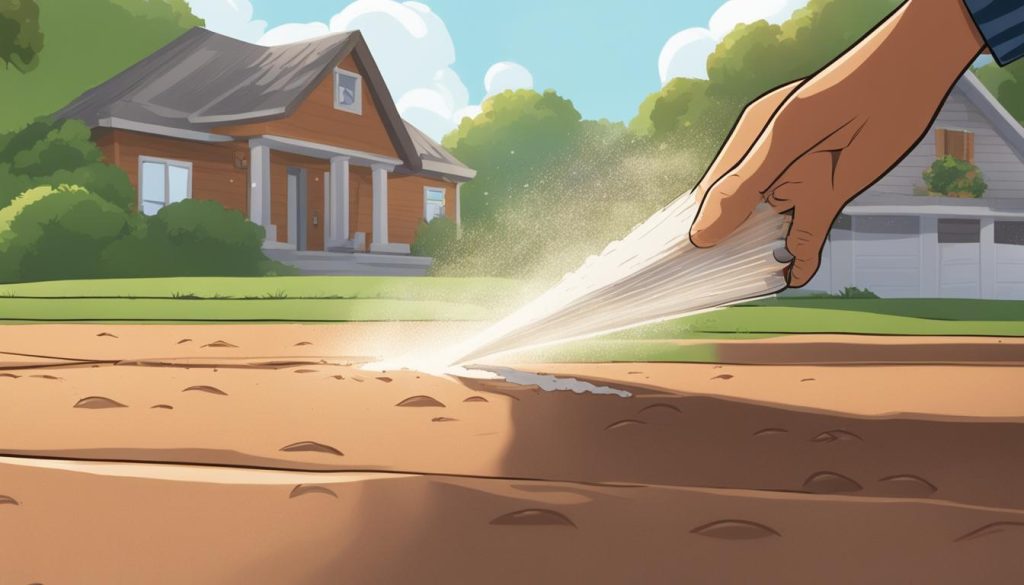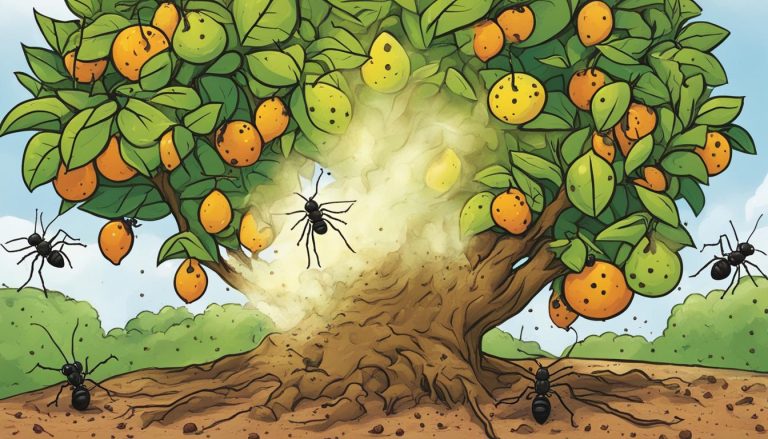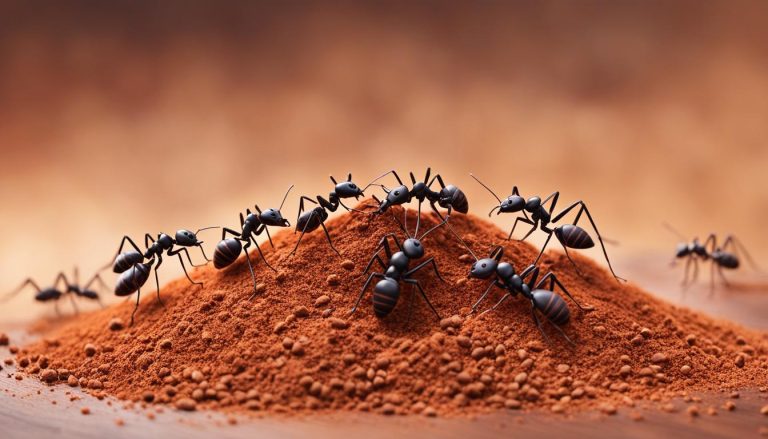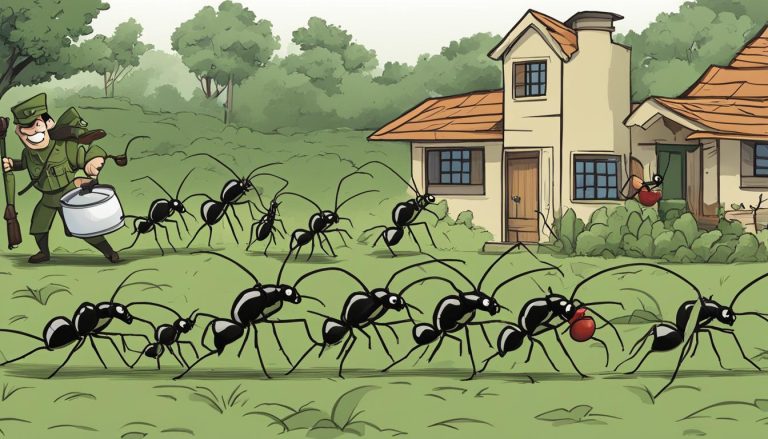If you’re tired of ants invading your home and looking for a non-toxic ant control method, then you’ve got to hear about Diatomaceous Earth (DE). This natural solution is not only organic ant control but also a budget-friendly and effective ant control technique suitable for any Aussie household. DE has been our mate in the battle against unwanted insects since 1836 and remains an essential tool for DIY ant control without using harsh chemicals.
As a powdery white substance, DE tackles those pesky ants by drying them out rather than poisoning them. It’s so safe that it’s part of many common household items, even food! Perfect for homes, gardens, and safe around young ones and pets, DE offers eco-friendly ant control at its finest. Apply it to ant trails, sit back, and watch it work over a couple of days. Keep it dry though, as moisture is the only thing that can dampen DE’s spirits – and its ant-zapping powers!
Key Takeaways
- DE is top-notch for ant control with diatomaceous earth.
- Say g’day to natural ant control and bye to harsh chemicals.
- Non-toxic ant control that’s safe around kids and pets.
- Keep your DE dry for super effective ant control.
- Aussies love an eco-friendly ant control option.
- Easy to use for all, making DIY ant control a breeze.
- Organic ant control that’s gentle on the planet.
Understanding Diatomaceous Earth and Its Ant-Killing Properties
Unravelling the secrets of diatomaceous earth ant killer reveals a world where effective ant control meets non-toxic ant control. Let’s unlock the potential of this age-old remedy, ensuring our homes remain both safe and ant-free.
What Is Diatomaceous Earth (DE)?
Diatomaceous earth, commonly known as DE, originates from the ancient, fossilised skeletons of tiny aquatic organisms known as diatoms. Their remains are rich in silica, attributing to DE’s potent ant infestation control properties. Through time, these microscopic creatures have contributed immensely to our planet’s oxygen supply, yet their most extraordinary attribute may just be their capacity to provide child-friendly and pet-friendly ant control.
How DE Works Against Ants
DE tackles ant problems by a purely mechanical means. Its microscopic, razor-sharp edges act as a lethal obstacle for ants, piercing their exoskeletons and absorbing the essential fats and oils from their bodies. Dehydration swiftly follows, leaving ants and other unwanted pests like ticks and scorpions completely vanquished. Importantly, ants cannot develop immunity to DE, making it an enduring solution for safe ant control.

The Safety of DE for Home Use
Recognised by the Organic Materials Review Institute, DE is the epitome of non-toxic ant control. It’s important, however, to distinguish between food-grade DE, which is suitable for use around children and pets, and pool-grade DE, which is not recommended for home pest control. Here are some quick tips on safely using DE:
- Opt for food-grade DE for home ant control.
- Wear a dust mask when applying to prevent inhalation.
- Avoid using around moisture, as DE loses effectiveness when wet.
In essence, this remarkable substance offers a non-toxic, safe ant control alternative that stands up to scrutiny in even the most cautious of households.
The Do’s and Don’ts of Applying Diatomaceous Earth for Ant Control
Embarking on a DIY ant control journey? Seize the prowess of diatomaceous earth ant killer and arm yourself with these straightforward tips to safeguard your Aussie home naturally and effectively. Here’s how to employ DE for effective ant control and maintain an organic ant control strategy.

- Ensure DE remains dry to retain its lethal effectiveness against ants.
- Lightly cover ant trails, foundations, and plant bases with a thin layer of DE.
- Avoid application during wet conditions; yet, once dried, DE resumes its duty.
- Reapply weekly to keep your space invulnerable to ant invasions.
- Patience is crucial; some ants may take 24 hours to be eliminated.
Remember, consistency is key in the battle against these tiny foes. Regular application is your best defense in maintaining a sustainable, ant-free environment. Stick with your plan, and you’ll find your ant troubles becoming a thing of the past.
Conclusion
In the persistent battle against ant invasions, diatomaceous earth (DE) emerges as a steadfast ally. It’s crucial, however, to harness the virtue of patience when using this natural remedy. DE doesn’t wave a magic wand for an instant fix; rather, it demands a little time to reach its full ant control potential. The timeline for victory over the ant legions can vary, influenced by factors such as local weather conditions, the specific ant species under siege, and how strategically DE has been deployed throughout your threatened territory.
Patience Is Key: DE’s Timeframe for Eliminating Ant Infestations
Rome wasn’t built in a day, and similarly, DE requires several days to send your six-legged foes packing. A methodical approach—reapplying DE as needed and keeping a watchful eye on ant traffic—will pay dividends. Steadfastness will see your home become a no-ant zone, reclaiming peace from these tenacious intruders. Such effective ant control, as offered by DE, is a true game-changer in maintaining an ant-free home.
Why DE is a Preferred Choice for Eco-Friendly and Safe Ant Control
Eco-conscious Australians can breathe a sigh of relief; DE provides a means of natural ant control that aligns with their environmental values. Because it’s void of toxic chemicals, it’s not only safer for your family and pets, but it also respects the delicate ecological balance in your backyard. You won’t find harm befalling the beneficial bugs that keep your garden thriving or any stray harm to the broader environment. For an eco-friendly, safe, and natural solution, DE ticks all the boxes as an exemplary choice for ant control within Aussie homes.
FAQ
What Is Diatomaceous Earth (DE) and How Is It Used for Ant Control?
Diatomaceous Earth, or DE, is a natural, powdery substance made from the fossilized remains of diatoms, a type of algae. It’s used for ant control by spreading the powder along ant trails and infested areas. DE works mechanically, not chemically, to kill ants by absorbing the oils and fats from the ant’s exoskeleton, leading to dehydration and death.
Is Diatomaceous Earth Safe to Use Around Children and Pets?
Yes, food-grade Diatomaceous Earth is considered safe to use around both children and pets. It’s a non-toxic substance that’s even used in some food products. However, it’s recommended to apply it carefully to avoid inhalation, which can be irritating to the lungs, so wearing a dust mask during application is advisable.
How Does Diatomaceous Earth Work Against Ants?
DE works by physically damaging the exoskeleton of ants, which causes them to dehydrate and die. The sharp edges of the DE particles cut through the protective layer of the ants, allowing moisture to escape from their bodies. This method ensures that ants will not develop resistance, making DE an effective long-term solution for ant control.
Can Diatomaceous Earth Be Used Outdoors for Ant Control?
Absolutely. Diatomaceous Earth can be used both indoors and outdoors. For outdoor use, sprinkle DE along ant trails, around the perimeter of your house, and near plants. It’s essential to apply DE when conditions are dry, as moisture will render it less effective until it dries out again.
How Long Does It Take for Diatomaceous Earth to Affect Ant Populations?
The effectiveness of DE on ants can vary. Some may die within 24 hours, while others may take several days. Factors such as the size of the ant infestation, the type of ants, and the application method can affect the time frame. Regular application and monitoring are key for successful ant control with DE.
What Type of Diatomaceous Earth Should Be Used for Ant Control?
Always use food-grade Diatomaceous Earth for ant control, especially if you’re using it in areas accessible to children and pets. Food-grade DE is safe and non-toxic, while pool-grade DE is not meant for ant control and can be harmful due to its different processing methods.
Can Diatomaceous Earth Be Used During Rainy Weather?
Diatomaceous Earth loses its effectiveness when wet, so it’s not recommended to apply it during rainy weather or when you expect rain. If DE does get wet, wait for it to dry out completely as it can then regain its ant-killing properties.
Does Diatomaceous Earth Affect Beneficial Insects or the Environment?
Diatomaceous Earth is considered an eco-friendly ant control option because it doesn’t contain harmful chemicals. While it can kill any insect it comes into close contact with by causing dehydration, when used carefully and targetedly, you can minimize its impact on beneficial insects.
Is Diatomaceous Earth Effective Against Other Pests?
Yes, in addition to being an effective ant killer, Diatomaceous Earth also works against a variety of other crawling insects such as cockroaches, fleas, bed bugs, and even some types of spiders and scorpions. It works on these pests in the same way it works on ants, by drying them out.






